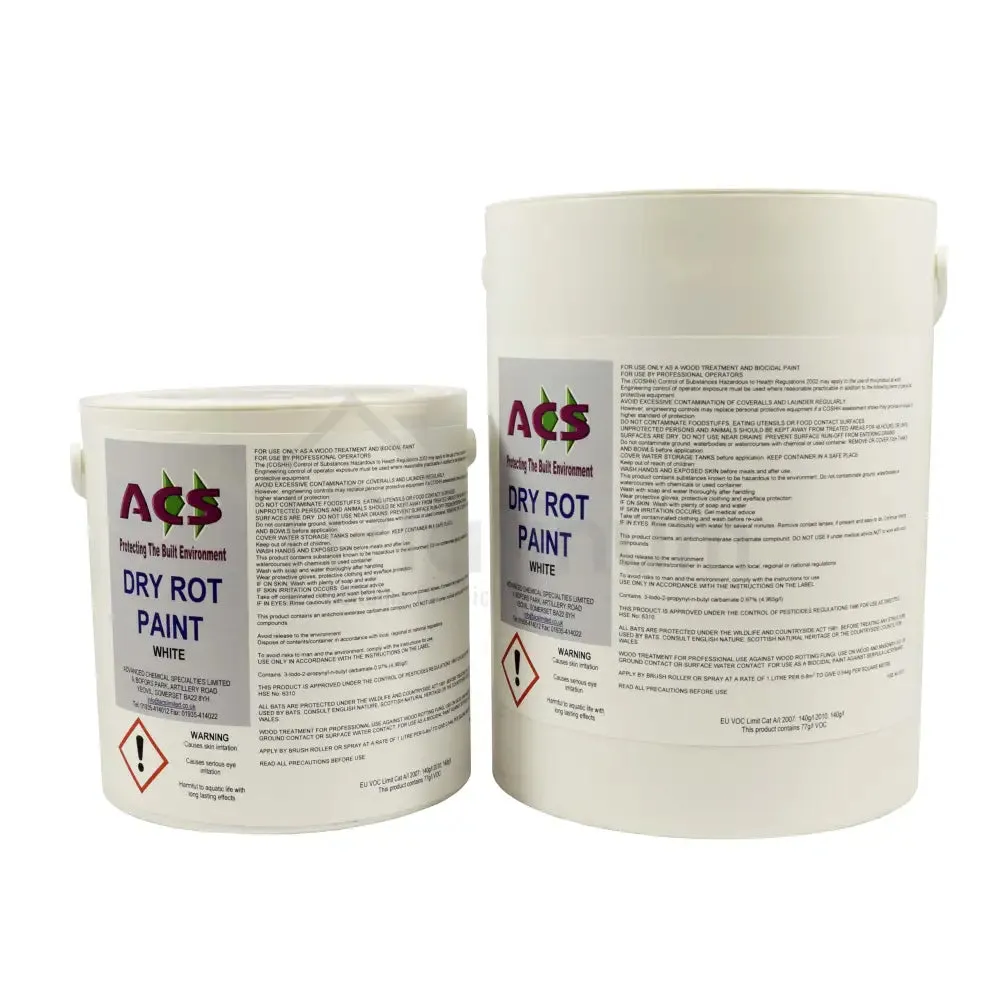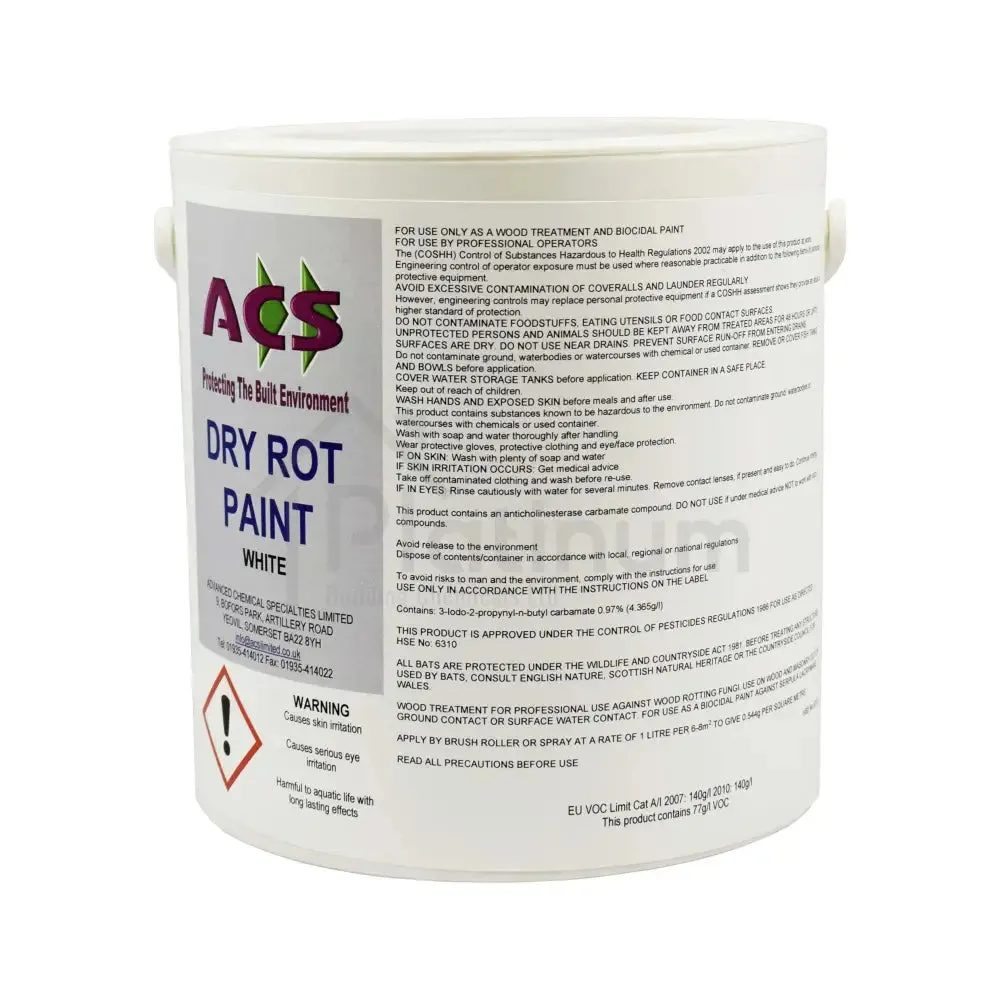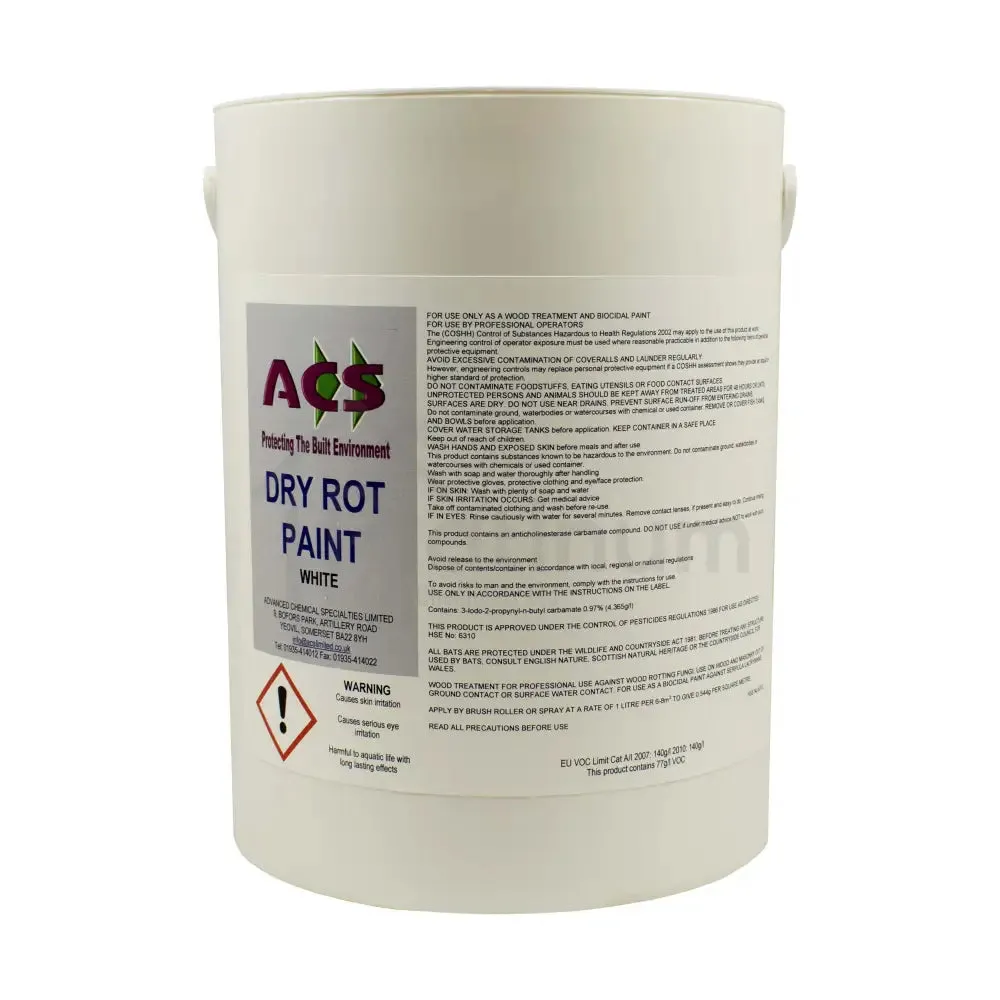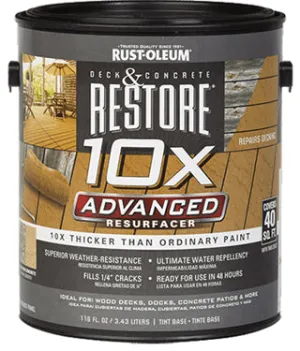ACS Dry Rot Paint is a specially formulated preservative emulsion coating that effectively controls fungal growth and infection, specifically targeting Dry Rot (Serpula Lacrymans). This versatile product can be applied on various surfaces such as brickwork, masonry, render, and timber.
Although it is not intended for 'eradicating' Dry Rot, ACS Dry Rot Paint is ideal for protecting timber in the vicinity of a fungal outbreak, as well as for reinstating timber after an outbreak.
ACS Dry Rot Paint is especially beneficial for coating the back portions of joinery, such as skirtings and architraves, and concealed parts of window and door framework.
Description
ACS Dry Rot Paint
✔️ Effectively controls fungal growth and infection, specifically targeting Dry Rot (Serpula Lacrymans), providing robust protection.
✔️ Ideal for protecting timbers in proximity to fungal outbreaks and for reinstating timber after an outbreak, ensuring long-term integrity.
✔️ Perfect for coating joinery and framework, such as skirtings, architraves, and concealed parts of window and door frameworks, safeguarding against fungal growth.
✔️ Highly visible preservative emulsion with low mammalian toxicity and low VOC content, ensuring safety and easy identification of treated areas.
✔️ Quick-drying and non-flammable, allowing for efficient project completion and minimising disruption while promoting a safer working environment.
Advanced Protection Against Dry Rot and Fungal Growth
ACS Dry Rot Paint is a specialised coating designed to protect surfaces from the damaging effects of fungal growth, specifically targeting Dry Rot (Serpula Lacrymans). With a unique formulation and a powerful active ingredient, this high-performance paint offers reliable protection for brickwork, masonry, render, and timber, making it an essential tool in preventative maintenance against fungal infections.
Preventative Shield for Restoration and Maintenance
It is important to note that ACS Dry Rot Paint does not eradicate Dry Rot or other fungal infections. Instead, it serves as a protective barrier, helping to safeguard timbers near a fungal outbreak or those used during restoration. By applying ACS Dry Rot Paint, joinery elements such as skirtings, architraves, and hidden sections of window and door frameworks are effectively shielded from potential fungal damage, prolonging their lifespan and preserving their quality.
Powerful Active Ingredient for Lasting Protection
At the heart of ACS Dry Rot Paint’s effectiveness is its active ingredient, 3-Iodo-2-Propynyl-N-Butyl Carbamate, with a concentration of just over 1.0% w/w. This potent compound has been carefully selected for its proven efficacy in inhibiting Dry Rot and other decay fungi. The paint’s highly visible preservative emulsion ensures that treatment is applied accurately and provides a visual confirmation of coverage.
Environmentally Conscious Formulation
ACS Dry Rot Paint combines powerful protection with safety and environmental responsibility. Its low mammalian toxicity makes it a safer option for use around humans and pets once the paint has dried, while its low VOC (Volatile Organic Compounds) content reduces environmental impact, supporting sustainable building practices. The paint’s quick drying time further contributes to efficient project completion, minimising downtime and disruption.
Versatile Application for Masonry and Timber
One of the standout features of ACS Dry Rot Paint is its versatility. Equally effective on masonry and timber, this adaptable product is invaluable for professionals working in varied environments. Its comprehensive testing and approval by the Health and Safety Executive (HSE Approval No. 6310) underscore its safety and reliability, offering peace of mind for users seeking a trusted solution to fungal protection.
ACS Dry Rot Paint provides an essential protective measure for surfaces vulnerable to fungal attack, delivering strong, effective coverage while prioritising safety and environmental sustainability.
Product Approvals
ACS Dry Rot Paint carries the HSE Approval No 6310.
Product Benefits
Effective Control of Fungal Growth and Infection: ACS Dry Rot Paint tackles fungal infections, specifically targeting Dry Rot (Serpula Lacrymans). Its powerful formulation acts as a barrier, preventing the spread of fungal growth and reducing the risk of further damage.
Protection for Proximity Timbers: When a fungal outbreak occurs, it is crucial to protect timbers in close proximity to the infected area. ACS Dry Rot Paint offers the necessary shield, ensuring the continued integrity of adjacent timbers.
Reinstate Timbers after Outbreak: Following a fungal outbreak, reinstating affected timbers is necessary. ACS Dry Rot Paint is an excellent choice for this purpose, providing a protective coating to safeguard against future infections.
Ideal for Joinery and Framework: Joinery components such as skirtings, architraves, window frames, and door framework are vulnerable to fungal infections. ACS Dry Rot Paint is uniquely formulated to coat these concealed areas effectively, providing thorough protection.
Highly Visible Preservative Emulsion: The formulation of ACS Dry Rot Paint ensures its visibility, facilitating easy identification of treated areas. This promotes accurate application and enhances overall treatment efficacy.
Surface Biocide and Sterilising Treatment: The active ingredient, 3-Iodo-2-Propynyl-N-Butyl Carbamate, acts as a surface biocide, effectively targeting Dry Rot and other decay fungi. This sterilising treatment hinders the growth and spread of fungal infections.
Low Mammalian Toxicity: ACS Dry Rot Paint has undergone stringent testing to ensure its safety for use around humans and pets. With low mammalian toxicity, it poses minimal risk, allowing for peace of mind during application.
Low VOC and Quick Drying: Ensuring a reduced environmental impact, ACS Dry Rot Paint contains low Volatile Organic Compounds (VOCs). Its quick drying time ensures efficient project completion, minimising downtime and disruption.
Typical Applications
Residential Buildings: ACS Dry Rot Paint is highly suitable for protecting timbers in residential buildings, including houses, apartments, and cottages. Its effective control of fungal growth and infection ensures the longevity of structural elements.
Commercial Properties: In commercial settings such as offices, retail establishments, and warehouses, ACS Dry Rot Paint provides invaluable protection for timbers susceptible to fungal infections. Its versatility lends itself well to a wide range of applications.
Public Buildings: Public buildings such as schools, hospitals, and community centers can benefit from ACS Dry Rot Paint. By employing this product, the risk of structural damage due to fungal growth is significantly reduced, ensuring the safety of occupants.
Restoration and Construction Projects: ACS Dry Rot Paint is an indispensable tool in restoration and construction projects, specifically during the reinstatement of timber components. Its ability to coat concealed areas effectively makes it an ideal choice for professionals in the field.
Architectural Features and Joinery: Architectural elements such as skirtings, architraves, window frames, and door framework require robust protection against fungal infection. ACS Dry Rot Paint effectively shields these vulnerable areas, preserving their integrity.
Active Ingredients
3-Iodo-2-Propynyl-N-Butyl Carbamate (1.0% w/w)
3-Iodo-2-Propynyl-N-Butyl Carbamate, often abbreviated as IPBC, is a highly effective biocidal compound frequently used in wood preservation and fungal protection applications due to its powerful antifungal and antibacterial properties. At a concentration of 1.0% w/w in ACS Dry Rot Paint, IPBC works by disrupting the metabolic processes of fungi, preventing the growth and spread of Dry Rot (Serpula Lacrymans) and other decay-causing organisms.
This compound targets and inhibits key enzymatic pathways within fungal cells, making it particularly effective at halting fungal proliferation on a variety of surfaces. IPBC is prized for its longevity and resistance to environmental degradation, which means it continues to provide protective benefits long after application. In addition to its efficacy against fungal growth, IPBC is also known for its low toxicity to mammals and humans, offering a level of safety that aligns with residential and commercial usage standards.
Furthermore, it has a relatively low environmental impact, as it degrades at a controlled rate, minimising its residual presence in ecosystems while still maintaining sufficient durability to protect treated surfaces effectively. Its broad-spectrum activity and compatibility with a range of materials make it an ideal active ingredient for a product designed to shield against dry rot and other structural fungi.
Application
Health & Safety Recommendations
When using ACS Dry Rot Paint, it is essential to follow standard labour hygiene practices to ensure safe handling. Always wear appropriate personal protective equipment (PPE), including gloves, safety goggles, and a face mask, to avoid direct contact with the paint and any airborne particles.
Proper ventilation should be maintained in enclosed spaces to minimise inhalation risks. Before starting, consult the product’s label and Material Safety Data Sheet (MSDS) for detailed safety information. Ensure that children and pets are kept away from the treatment area during and after application.
Substrate Suitability
ACS Dry Rot Paint is formulated to treat and prevent dry rot on both masonry and timber surfaces. It is effective on smooth and rough-sawn timbers as well as porous and non-porous masonry surfaces. This product provides robust protection and sterilisation, especially in areas vulnerable to fungal outbreaks.
However, it is vital to ensure all surfaces are free from salt efflorescence before application, as this can impair adhesion and effectiveness. If efflorescence is present, treat it with before applying the dry rot paint.
Substrate Preparation
Begin surface preparation by thoroughly cleaning the treatment area using a stiff brush, extending at least 300 mm beyond the last visible extent of the fungal outbreak.
Remove any loose or flaking materials, surface growth, and fungal strands. Efforts should be made to minimise dust levels during this process, as dust can interfere with adhesion. Collect all dust and debris and dispose of it in accordance with good site practice.
For surfaces affected by efflorescence, apply to ensure a clean, stable base for the paint. Proper surface preparation is critical to maximising the effectiveness of ACS Dry Rot Paint.
Application Method
Before application, stir ACS Dry Rot Paint thoroughly to ensure an even distribution of active ingredients. For masonry and wall areas, apply two generous coats using a brush or roller, working the product into all cracks, joints, and defects.
Allow the first coat to dry until it is touch dry before applying the second coat, which ensures maximum protection and coverage. For smooth timber surfaces, apply one liberal coat and allow it to dry completely.
For rough-sawn or porous timber, apply two liberal coats, allowing the first coat to become touch dry before applying the second. This application technique ensures a durable protective layer against dry rot.
Coverage
The coverage rate of ACS Dry Rot Paint varies depending on the type and condition of the substrate. On average, one litre of paint covers between 2 to 8m².
Porous or rough surfaces may absorb more paint, resulting in lower coverage, while smooth, non-porous surfaces may allow for greater coverage. It is advisable to assess the surface condition prior to application to estimate the amount of paint required accurately.
Finishing
Once ACS Dry Rot Paint has fully dried, inspect the treated area to confirm complete and even coverage, particularly in hard-to-reach spots. This paint does not require additional finishing or top-coating, as it is designed to form a protective barrier against fungal growth upon curing.
However, for specific project requirements, additional compatible finishes may be applied if necessary.
Cleaning
Clean all tools and any accidental spills immediately after application using water. Rinse brushes, rollers, and other application tools thoroughly to remove all paint residue before it dries, as dried paint may require mechanical cleaning for complete removal.
Maintaining clean tools during and after application will preserve their effectiveness for future use.
Other Information
ACS Dry Rot Paint should be protected from frost during storage and application. The product is not suitable for use at temperatures below 5°C, as this can affect curing and effectiveness.
Coverage rates vary depending on the substrate type and condition, with an approximate range of 2-8m² per litre. Store the product in a cool, dry place, ensuring it is tightly sealed and away from direct sunlight to maintain its shelf life and performance quality.
FAQ's
Q) What is ACS Dry Rot Paint?
A) ACS Dry Rot Paint is a preservative emulsion coating designed to control and prevent the growth of fungal infections, particularly Dry Rot (Serpula Lacrymans). It can be applied to various surfaces including brickwork, masonry, render, and timber to protect timbers in close proximity to a fungal outbreak or to reinstate timber after an outbreak has occurred.
Q) How does ACS Dry Rot Paint work?
A) The paint works by creating a protective barrier on treated surfaces, utilising its active ingredient, 3-Iodo-2-Propynyl-N-Butyl Carbamate, at a concentration of just over 1.0% w/w. This compound effectively inhibits the growth of Dry Rot and other decay fungi, providing a sterilising treatment that prevents further spread.
Q) Can ACS Dry Rot Paint eradicate existing Dry Rot?
A) ACS Dry Rot Paint is not intended to eradicate Dry Rot or other fungal infections. Instead, it acts as a protective measure, shielding timber and other surfaces from being affected by nearby fungal outbreaks.
Q) Where can ACS Dry Rot Paint be applied?
A) It is ideal for use on brickwork, masonry, render, and timber surfaces. Specifically, it is beneficial for coating the back portions of joinery, such as skirtings and architraves, concealed parts of window and door framework, and other areas vulnerable to fungal infections.
Q) Is ACS Dry Rot Paint suitable for both residential and commercial applications?
A) Yes, ACS Dry Rot Paint is suitable for a wide range of settings, including residential buildings, commercial properties, public buildings, and is also invaluable in restoration and construction projects.
Q) What makes ACS Dry Rot Paint different from other fungal protective coatings?
A) Its unique formulation, with a highly effective active ingredient specifically selected for its efficacy against Dry Rot and other decay fungi, sets it apart. Additionally, its highly visible preservative emulsion acts as a visual indicator to confirm treatment, along with benefits like low mammalian toxicity, low VOC content, quick drying time, and versatility across both masonry and timber surfaces.
Q) How is ACS Dry Rot Paint applied?
A) For maximum protection, it should be applied using a brush or roller, with two liberal coats on exposed wall areas and one or two coats on timber, depending on the timber's porosity. The second coat should be applied when the first is touch dry.
Q) Can ACS Dry Rot Paint be applied over existing paint or varnish?
A) The surface needs to be properly prepared before application, which includes removing any existing paint, varnish, dirt, loose material, and ensuring it is free from efflorescence. The effectiveness of ACS Dry Rot Paint depends on its ability to penetrate the substrate directly.
Q) What is the coverage rate of ACS Dry Rot Paint?
A) The coverage rate is approximately 2-8 square meters per litre, varying with the type and condition of the substrate.
Q) Is ACS Dry Rot Paint safe for use around humans and pets?
A) Yes, the product has been tested to ensure low mammalian toxicity, making it safer for use in environments occupied by humans and pets, compared to more toxic alternatives.
Q) How quickly does ACS Dry Rot Paint dry?
A) The drying time is relatively quick, allowing for faster project completion. Specific drying times can vary based on environmental conditions but generally, the second coat can be applied once the first coat is touch dry.
Q) Does ACS Dry Rot Paint have any environmental impact?
A) Its formulation is designed with low VOC content, aiming to minimise environmental impact and align with sustainable practices.
Q) Can ACS Dry Rot Paint be overpainted or coated after application?
A) Yes, once dry, surfaces treated with ACS Dry Rot Paint can be overpainted or coated, allowing for seamless integration into the restoration or construction process without compromising the aesthetic appeal of the project.
Q) How should surfaces be prepared before applying ACS Dry Rot Paint?
A) Surfaces should be cleaned thoroughly using a stiff brush to remove all surface growth, strands, dirt, and debris. Minimise dust levels and ensure the surfaces are free of efflorescence for optimal adhesion and effectiveness.
Q) What is the active ingredient in ACS Dry Rot Paint and what does it do?
A) The active ingredient is 3-Iodo-2-Propynyl-N-Butyl Carbamate, present at just over 1.0% w/w. It acts as a surface biocide, targeting and inhibiting the growth of Dry Rot and other decay fungi.
Q) Is ACS Dry Rot Paint approved for professional use?
A) Yes, it carries the HSE Approval No. 6310, indicating it meets stringent safety and effectiveness standards set by the Health and Safety Executive for professional use.
Q) What precautions should be taken when applying ACS Dry Rot Paint?
A) Ensure the area is well-ventilated, wear appropriate protective clothing, and avoid application in temperatures below 5°C. Also, protect from frost and clean any spillages with water immediately. It's important to follow all safety guidelines provided by the manufacturer to ensure safe and effective application.
Q) Can ACS Dry Rot Paint be used in high-moisture environments?
A) Yes, ACS Dry Rot Paint is suitable for use in high-moisture environments. Its formulation provides a robust barrier against fungal growth, which is particularly valuable in areas susceptible to dampness and fungal outbreaks.
Q) How long does the protection offered by ACS Dry Rot Paint last?
A) The longevity of the protection provided will depend on the environmental conditions and the substrate's exposure to those conditions. However, the active ingredient in ACS Dry Rot Paint is designed to offer long-lasting protection against fungal growth.
Q) Does ACS Dry Rot Paint leave any visible residue or change the appearance of the treated surface?
A) ACS Dry Rot Paint is a highly visible preservative emulsion, which acts as a visual indicator of treatment. While it may alter the appearance of the surface slightly, it ensures easy identification of treated areas. Once dry, it can be overpainted or coated to match the surrounding area.
Q) How should equipment used with ACS Dry Rot Paint be cleaned?
A) Equipment and tools used for the application of ACS Dry Rot Paint should be cleaned with water immediately after use. This prevents the paint from drying on the equipment, ensuring they can be used again without issue.
Q) Is ACS Dry Rot Paint effective against other types of fungi besides Dry Rot?
A) While specifically formulated to target Dry Rot (Serpula Lacrymans), its active ingredient also provides a level of protection against a broader range of decay fungi, making it a versatile option for fungal control.
Q) Can ACS Dry Rot Paint be applied to previously infected areas?
A) Yes, ACS Dry Rot Paint can be applied to areas previously infected with Dry Rot or other fungi after the area has been properly treated and the source of moisture has been addressed. It acts as a protective barrier to prevent future infections.
Q) What is the best time of year to apply ACS Dry Rot Paint?
A) ACS Dry Rot Paint can be applied at any time of year, provided the temperature is above 5°C and the surface is dry. However, applying during dry, warmer months may facilitate quicker drying and reduce the likelihood of moisture affecting the application.
Q) Are there any specific storage requirements for ACS Dry Rot Paint?
A) ACS Dry Rot Paint should be stored in a cool, dry place, away from frost and direct sunlight. Ensure the container is tightly sealed to prevent the paint from drying out or being contaminated.
Q) How can I ensure maximum efficacy when using ACS Dry Rot Paint?
A) For maximum efficacy, ensure the substrate is properly prepared by cleaning and removing any loose material. Apply the paint as directed, ensuring thorough coverage and allowing adequate drying time between coats. Addressing any underlying issues such as moisture intrusion will also enhance the paint's effectiveness.
Q) Is there any risk of ACS Dry Rot Paint affecting indoor air quality?
A) With its low VOC content and low mammalian toxicity, ACS Dry Rot Paint is designed to minimise any impact on indoor air quality, making it a safer choice for indoor applications compared to more toxic alternatives.
Q) How does ACS Dry Rot Paint contribute to sustainable building practices?
A) By providing long-lasting protection against fungal decay with minimal environmental impact, ACS Dry Rot Paint contributes to sustainable building practices by extending the life of timber and masonry structures, reducing the need for frequent replacements or repairs.
Q) Can ACS Dry Rot Paint be used as a standalone treatment for Dry Rot?
A) While ACS Dry Rot Paint offers excellent protection against the spread of Dry Rot, it should be used as part of a comprehensive treatment plan that includes eliminating the source of moisture and removing heavily infected material to ensure the complete eradication of the fungus.
Data Sheets

















